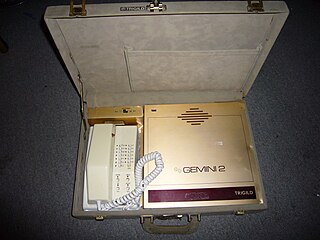
Ericsson is a Swedish multinational networking and telecommunications company headquartered in Stockholm. The company offers services, software and infrastructure in information and communications technology for telecommunications operators, traditional telecommunications and Internet Protocol (IP) networking equipment, mobile and fixed broadband, operations and business support services, cable television, IPTV, video systems, and an extensive services operation.

A telephone switchboard is a telecommunications system used in the public switched telephone network or in enterprises to interconnect circuits of telephones to establish telephone calls between the subscribers or users, or between other exchanges. The switchboard was an essential component of a manual telephone exchange, and was operated by switchboard operators who used electrical cords or switches to establish the connections.
Telephony is the field of technology involving the development, application, and deployment of telecommunication services for the purpose of electronic transmission of voice, fax, or data, between distant parties. The history of telephony is intimately linked to the invention and development of the telephone.

A telephone company, also known as a telco, telephone service provider, or telecommunications operator, is a kind of communications service provider (CSP) that provides telecommunications services such as telephony and data communications access. Many telephone companies were at one time government agencies or privately owned but state-regulated monopolies. The government agencies are often referred to, primarily in Europe, as PTTs.

A telephone call is a connection over a telephone network between the called party and the calling party.
A mobile network operator or MNO, also known as a wireless service provider, wireless carrier, cellular company, or mobile network carrier, is a provider of wireless communications services that owns or controls all the elements necessary to sell and deliver services to an end user including radio spectrum allocation, wireless network infrastructure, back haul infrastructure, billing, customer care, provisioning computer systems and marketing and repair organizations.

Swisscom AG is a major telecommunications provider in Switzerland. Its headquarters are located in Worblaufen near Bern. The Swiss Confederation owns 51.0 percent of Swisscom AG. According to its own published data, Swisscom holds a market share of 60% for mobile, 67% for broadband and 33% for TV telecommunication in Switzerland. Its Italian subsidiary Fastweb is attributed 16% of private clients and 29% of corporate clients share of Italian broadband and is also active in the mobile market.
111 is the emergency telephone number in New Zealand. It was first implemented in Masterton and Carterton on 29 September 1958, and was progressively rolled out nationwide with the last exchanges converting in 1988.

In the early days of telephony, through roughly the 1960s, companies used manual telephone switchboards, and switchboard operators connected calls by inserting a pair of phone plugs into the appropriate jacks.
In telephony, an automated attendant allows callers to be automatically transferred to an extension without the intervention of an operator/receptionist. Many AAs will also offer a simple menu system. An auto attendant may also allow a caller to reach a live operator by dialing a number, usually "0". Typically the auto attendant is included in a business's phone system such as a PBX, but some services allow businesses to use an AA without such a system. Modern AA services can route calls to mobile phones, VoIP virtual phones, other AAs/IVRs, or other locations using traditional land-line phones.

A business telephone system is a multiline telephone system typically used in business environments, encompassing systems ranging from the small key telephone system (KTS) to the large private branch exchange (PBX).

Mobile radio telephone systems were telephone systems of wireless type that preceded the modern cellular mobile form of telephony technology. Since they were the predecessors of the first generation of cellular telephones, these systems are sometimes retroactively referred to as pre-cellular systems. Technologies used in pre-cellular systems included the Push to Talk, Mobile Telephone Service (MTS), Improved Mobile Telephone Service (IMTS), and Advanced Mobile Telephone System (AMTS) systems.
These early mobile telephone systems can be distinguished from earlier closed radiotelephone systems in that they were available as a commercial service that was part of the public switched telephone network, with their own telephone numbers, rather than part of a closed network such as a police radio or taxi dispatch system.

The history of mobile phones covers mobile communication devices that connect wirelessly to the public switched telephone network.

Telecommunications Services of Trinidad and Tobago Limited is a large telephone and Internet service provider in Trinidad and Tobago. The company, which is jointly owned by the Government of Trinidad and Tobago and Cable & Wireless, was formed out of a merger of Telco and Textel. TSTT no longer holds a monopoly in fixed-line telephone services due to FLOW introducing a fixed-line service of their own, and their cellular monopoly was broken in June 2005 when licenses were granted to Digicel and Laqtel.
A mobile phone operator, wireless provider, or carrier is a mobile telecommunications company that provides wireless Internet GSM services for mobile device users. The operator gives a SIM card to the customer who inserts it into the mobile device to gain access to the service.

This history of the telephone chronicles the development of the electrical telephone, and includes a brief review of its predecessors.
These are some of the links to articles that are telephone related.

A telephone number is a sequence of digits assigned to a fixed-line telephone subscriber station connected to a telephone line or to a wireless electronic telephony device, such as a radio telephone or a mobile telephone, or to other devices for data transmission via the public switched telephone network (PSTN) or other public and private networks.

A telephone exchange is a telecommunications system used in the public switched telephone network or in large enterprises. An exchange consists of electronic components and in older systems also human operators that interconnect (switch) telephone subscriber lines or virtual circuits of digital systems to establish telephone calls between subscribers.













